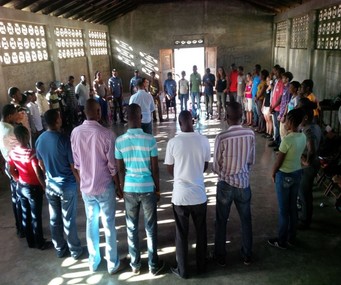With generous funding from the US Trade and Development Agency and the Nathan Cummings Foundation, EarthSpark International, Energy and Security Group, and The Haiti Energy Institute recently completed a countrywide market study of the potential for town-sized, solar-powered microgrids across Haiti. The study was conducted for EarthSpark’s Haitian social enterprise spin-off, Enèji Pwòp, S.A. in order to facilitate a fundable plan for microgrid development. Following a desk study of un-electrified Haitian towns, field research was undertaken in 89 rural towns from July-October of 2015. Research Parameters The study sample targeted towns with no or limited grid access. With the list of towns finalized, the surveys were designed with input from anthropologists, microgrid consultants, and energy policy advisors with a background in the Haitian cultural and energy contexts and focused upon the following research parameters: · Energy demand / energy expenditures · Private generation and appliance ownership · Current political situation · Strength of community organizations · Town infrastructure and ease of accessibility (police station, bank, wire transfer services, roads, ports, etc.) · Economic drivers and market activity · Key crops · Geographic distribution of buildings, town size / density · NGO and Diaspora presence Field Team The field research team consisted of 20 teams of two researchers, hailing mostly from Haiti, Canada, and the US. Thanks to partnerships with three local universities, Université Quisqueya, Université d’Etat d’Haïti, and Enstiti Travay Sosyal ak Syans Sosyal, 30 Masters level Haitian students were recommended by the deans of their respective universities for research positions. EarthSpark partnered with the Haitian Energy Institute, which was instrumental in managing logistics of the site visits and on-the-ground interviews. The partners ran a weeklong training session, or “microgrid bootcamp,” in Les Anglais, Haiti, home to EarthSpark’s first microgrid. The training included a multi-disciplinary curriculum on electricity, solar generation, survey methodology, and practice interviews.
An in-house geospatial analysis of each of the towns was undertaken to determine the following: estimate of potential connections, building density, and flood risk. GIS tools used for the study were Google EarthEngine API and QGIS. This project also included a desk study of relevant laws, regulations and decrees relevant to micro-grid development and operation in Haiti, outlining opportunities and challenges.
Next Steps
With this information in hand, EarthSpark and Enèji Pwòp are ever closer to reaching the goal of building 80 microgrids across Haiti. A public version of the report is forthcoming. Beyond Haiti, EarthSpark is now well positioned to leverage its research methodology and survey experience to undertake or facilitate similar market studies in other countries seeking visibility into microgrid development potential.
0 Comments
Your comment will be posted after it is approved.
Leave a Reply. |
EarthSpark supporters make our work possible. Thank you for considering a donation towards eliminating energy poverty in Haiti.
Read the full blog - click here!
|
EarthSpark International is a non-profit 501(c)3 organization.







